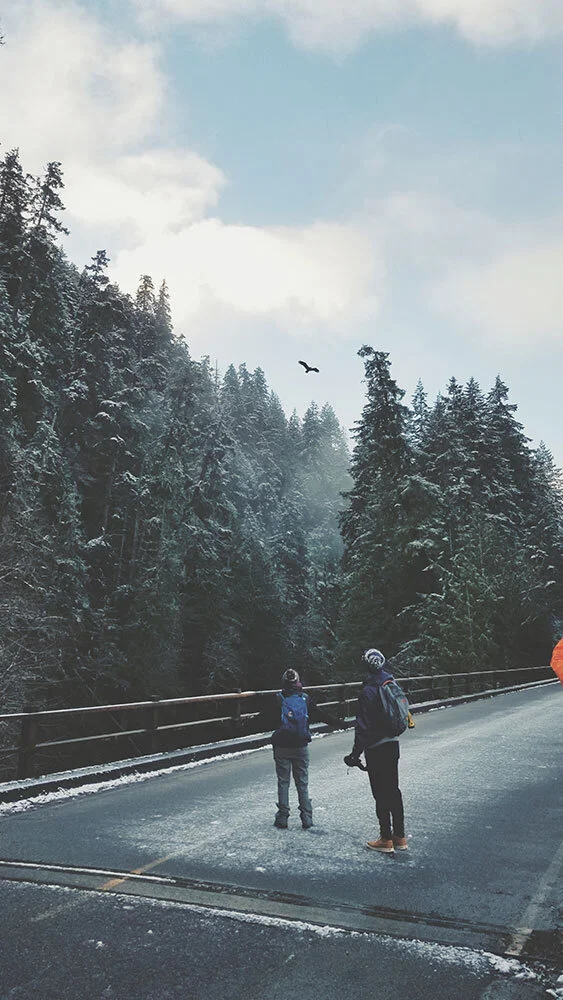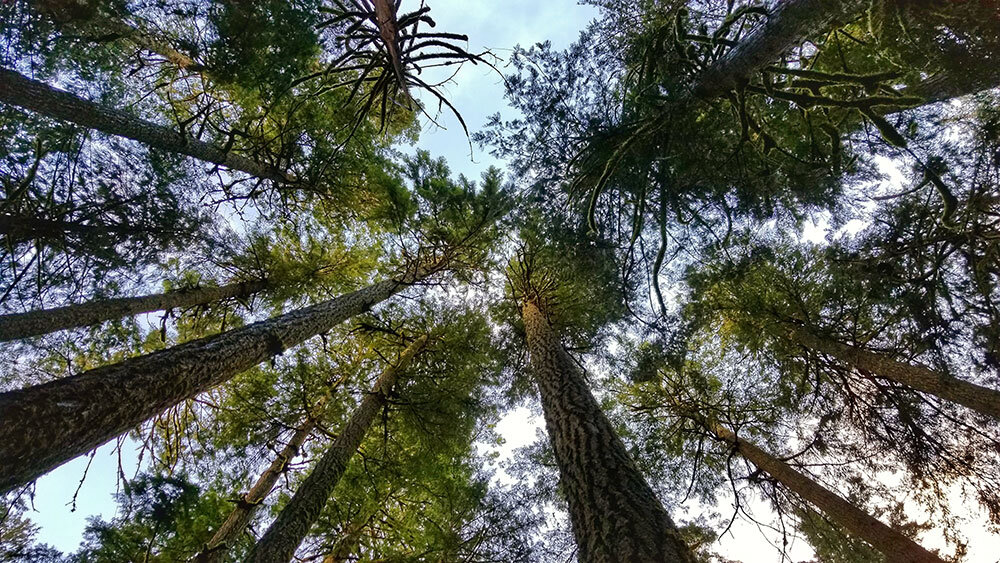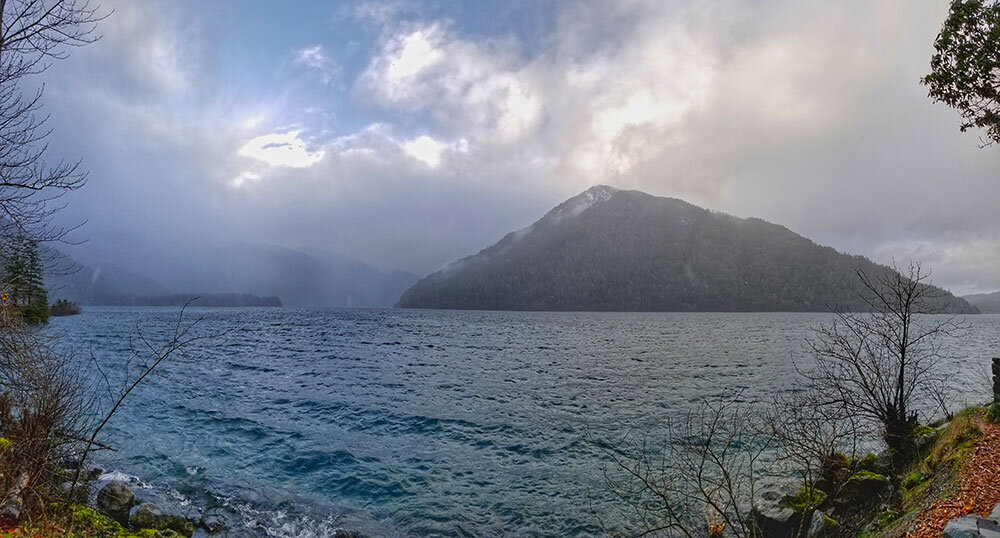Back to the Olympics
(A little preface. We are a family of five that loves to travel. We spend our days operating an outfitter and outdoors store (AO) in the heart of Pennsylvania’s Allegheny National Forest region, and love to help folks find that connection with nature. Being a seasonal outfitter, we are only able to travel in the off-season, primarily January and February. We’ve found this to be an unexpected gift from the universe, as it’s the off-season just about everywhere we go.)
After much discussion with our teenagers about winter 2020 traveling plans, weighing that they were neck-deep in some tough classes and that they’d already explored with us at Olympic twice previously, we all decided (for the first time ever) that they would stay home and we’d take our core crew from AO. None of them had been, and we were excited to show ‘em the places we’d fallen in love with over the years, while finding some new ones to add to that list.
We’d driven to Pittsburgh the night prior and caught an early 6am shuttle to the airport from our hotel nearby. Our driver was playful, crackin’ jokes and asking all sorts of questions. And he’d been to AO before and paddled the Allegheny! Small world! Once airborne Jen instantly made friends with a Canadian gal and her tiny human on the plane, so she played while the rest of us tried to catch a nap.
We learned our first couple times exploring Olympic, because we travel in the coldest months and camping isn’t an option, the key is to have a home base close to trailheads you plan to tackle. The first time we visited we had hours-long drives to and from the trail, spending more time in the car then in the forest. We’ve gotten better each time and were really excited with our solid plan for the next week. After getting off the plane in Seattle, we made a quick stop at McMenamins Elks Temple, and headed on the couple hour drive to our first Airbnb.
This place was as close as we’d ever been to the Elwha trailhead, or the Elwha River, a quick 5-minute drive from our doorstep, and visible from just about every window of the home we were staying in. We arrived after dark on day one, and talked over maps, deciding to shake off the travel, get acclimated and explore a few new places before tackling the Elwha. Tongue Point and Cape Flattery - we’re coming for you!
Tongue Point
A quick 20-minute drive got us to Tongue Point, part of the Salt Creek Recreation Area. We parked inside the gate and walked through the campground on foot to the eastern and western staircases.
The eastern staircase brought us to a cool old bunker that remains from the point's days as a World War II military camp. Named for General John L. Hayden, former commanding officer of Puget Sound harbor defenses, the 518-acre Camp Hayden military reservation at Tongue Point was part of the modernization of coastal defenses in 1940 with anti-motor torpedo boats, seacoast armament and anti-aircraft installations. Before war's end, the Camp Hayden military reservation concealed two heavily camouflaged, bomb-proofed two-gun batteries: one six-inch installation 2,000 feet up Striped Peak and a 16-inch battery on Tongue Point. The guns were test-fired only once. Housed in steel-shielded, canopied concrete bunkers designed to take a direct hit, the monster guns were 45 feet long, five feet thick at the breech, tapering to 16 inches in diameter at the point overlooking the Strait of Juan de Fuca. The turntable on which the gun and loading mechanism revolved was large enough to turn a small locomotive. Top-grade laminated steel barrels fired one-ton projectiles nearly 50,000 yards (approximately 28 miles).
The western staircase brought us to Tongue Point, and our first sea stack. At low tide you can explore the Tongue Point Marine Life Sanctuary, its tide pools world famous by marine biologists. Unfortunately for us, it wasn’t low tide, but we still wanted to stop and explore.
An interesting tidbit about Tongue Point: As we hiked to the reference mark, all our phones started buzzing with “Welcome to Canada!” messages.
Cape Flattery
Cape Flattery is the furthest northwest tip of the contiguous United States. Although the two-hour (one-way) drive from Tongue Point didn’t necessarily excite us, we’d never explored this trail before and really wanted to. It sits waaaay out there all by itself.
At one point our GPS took us on what turned into a really rough dirt road, with what appeared to be a giant pile of roadkill, near what we think was the roads ending point. (Confused? So were we!) Eeek! We could see the road we wanted to be on in the distance, but couldn’t get there! Some pretty hearty laughter ensued as we demanded Sue turn around immediately and get us out of there!
She did, and we quickly found our way back on the correct road. Thank goodness for the adventurous spirit of our AO crew as we drove the next hour through the twisty and windy roads. Poor Jen - every left-hand curve had her smooshed against the passenger door. I think we’d all agree though, it was well worth the smooshings and odd dirt road find.
This. Trail. Is. Incredible.
It’s managed and maintained by the Makah Tribe. The trail is very well taken care of with ample parking, a nice kiosk full of useful info, a fun giant chair for that silly pic, resting benches and periodic signage reminding folks to please stay on trail. It even has a platform perfect for reenacting your best “I’m the king of the woooorld!” scene from Titanic!
A mashup of hard gravel and raised wood bridge with some of the most dramatic, beautiful views - this is truly one of the most stunning hikes I’ve ever been on - from start to finish. At the very end of the trail, just before heading back, we spotted a seal!
Elwha River
I dream of this river.
The main reason we chose Olympic National Park as our getaway the first time we visited, and each time thereafter - the Elwha River. We don't have cable TV, and stumbled upon a documentary called DamNation on Netflix some years ago. If you haven't watched it, I highly recommend you do. Beyond the excellent educational component, the videography is absolutely stunning. We've since watched it dozens of times, to the point my kids can practically recite it. I had no idea an effort to free salmon could have such an impact on us, but I still can't help but tear up when I watch it.
Our plan was to rise before the sun for a hike into the Elwha River valley, up to the former site of Glines Canyon Dam. As we gathered outside the house, giant snowflakes surrounded us, falling in the dark. You could hear the Elwha in the distance. Magic.
When we arrived at the trailhead we realized we weren’t alone in our thought process, with a bunch of cars already there. By the time we got our packs on and organized, all but one were gone. Elwha hike!
Exploring along the Elwha isn't easy. Because this river hadn't been able to run free for over 100 years, when it finally did it washed out roads. We had to park and walk the road in for miles just to reach a trailhead. No bother to us though, in fact, we’d never been able to drive the road in through all our visits. A new bypass trail that cuts up around the road onto a beautiful mountainside was finally open as well, and we were excited to share the trek with our AO family.
In all our January and February visits to Olympic, we’ve never encountered snow on the Elwha. We’ve seen it on the mountains in higher elevations, and we’ve been prepared for it, but never experienced it until this trip. Pictures don’t do it justice. Although it brought some tricky footing in spots, it looked as though someone had sprinkled powdered sugar on a lush green, mossy forest. A little bit here… a bit more there… woops, a bit too much there. You had to stop numerous times just to look around and take it in.
We celebrated our arrival at Glines Canyon with peanut butter and jelly sandwiches and apples as we absorbed the view.
The National Park Service gives a great summary of this special place:
“For millennia, the Elwha River ran wild, connecting mountains and seas in a thriving ecosystem. The river proved to be an ideal habitat for anadromous (sea-run) fish, with eleven varieties of salmon and trout spawning in its waters. These fish thrived in the cold, clear waters of the Elwha River and historically served as an important food source for the Lower Elwha Klallam Tribe living along its banks.
American expansion spurred a continual demand for lumber. The growth of the logging industry in the region brought rapid change to the Olympic Peninsula and specifically to the Elwha River with the construction of two dams. The Elwha and Glines Canyon dams were built in the early 1900s, generating hydropower to supply electricity for the emerging town of Port Angeles and fueling regional growth on the Peninsula. However, construction of the dams blocked the migration of salmon upstream, disrupted the flow of sediment downstream, and flooded the historic homelands and cultural sites of the Lower Elwha Klallam Tribe.
For over a century, the web of ecological and cultural connections in the Elwha Valley were broken - then the river's story changed course. In 1992, Congress passed the Elwha River Ecosystem and Fisheries Restoration Act, authorizing dam removal to restore the altered ecosystem and the native anadromous fisheries therein. After two decades of planning, the largest dam removal in U.S. history began on September 17, 2011. Six months later the Elwha Dam was gone, followed by the Glines Canyon Dam in 2014. Today, the Elwha River once again flows freely from its headwaters in the Olympic Mountains to the Strait of Juan de Fuca.”
A free flowing Elwha River.
After our long day on the trail, and our final night in the Elwha house, we geeked out pretty hard while making dinner, watching DamNation while a free flowing Elwha River rolled downriver outside our window.
Port Angeles - Toga’s Soup House
If you’re headed to Olympic National Park, you’re headed to Port Angeles. Don’t miss Toga’s. Hands down the best food we have every time we’re here. It’s just a little cafe - homemade soups, salads and sammiches, good coffee, awesome service. Olympic visit = Toga’s visit. You’ll thank us later.
Marymere Falls
We broke up the drive to our next Airbnb home base with a quick 1.8 mile hike out to Marymere Falls, gazing at Lake Crescent as we drove there. Marymere is impressive at 90-foot-high! The trail to get there meanders through a towering green canopy of conifers and maples that makes you want to keep looking up. It’s a fun little adventure with twists and turns, bridge crossings over Barnes and Falls Creeks, and a bunch of stairs near the end leading you up close to the falls. Beautiful trail to stretch your legs and get some fresh air!
Exploring along the way…
We found Joyce General Store in the small town of Joyce, Washington. Sue and Jen not only share a birthday, but both their mom’s were named Joyce, and both are sorely missed, daily. This was a special stop. Afterward we hit low tide, stopping to explore a couple tide pools along the way. Limpets, anemones and hermit crabs galore! So many cool critters!
Rialto Beach
Jen, Sue and I woke up early and decided to catch a sunrise at Rialto Beach, being it was just down the road. When we arrived the wind was so intense you had to lean into it to stay upright, the ocean waves furiously crashing from afar. As we walked out toward the beach something white flew by us. We immediately thought it was toilet paper, giving each other disgusted looks of, “Ugh. Humans.” But as we got closer another flew past… then another. Coming up over the mound of earth between us and the beach we realized it wasn’t TP, but sea foam from the winter storm! Flying everywhere! We’d been sea foamed!
Hoh Rainforest
Our final adventure in Olympic, we attempted to find the One Square Inch of Silence, which has been named the quietest place in the United States. Located in the Hoh Rain Forest, it’s 3.2 miles from the Visitor’s Center above Mt. Tom Creek Meadows on the Hoh River Trail. The exact location is marked by a small red-colored stone placed on top of a moss-covered log.
Of course sometimes Mama Nature has other plans, and this was one of those times. It’d been raining for days in the Hoh. (We’d find out the next day that the road into this area had been washed out completely and access was not possible.) We gave it our best shot, traversing numerous washed out areas for over 2 miles, but finally decided to turn around when there was no trail remaining for as far as the eye could see.
No harm though, the Hoh Rainforest is just pure magic. I’d be completely content sitting among the moss covered trees in the parking lot on a January day. When we got back to the Visitors Center we meandered through the Hall of Mosses to finish our day.
Climbed (slipped, tripped and fell upon) some mountainsides; crossed a bunch of foot bridges; got misted by multiple waterfalls and sea foamed by the Pacific Ocean; came across an unexpected pile of roadkill on a wrong turn in the middle of nowhere; saw seal, deer and multiple bald eagle; learned about ocean critters and tide pools; explored a WWII bunker; and shared a bunch of giggles while also testing our mettle at times, with a great group of humans.
How grateful are we that these places exist. When the daily grind creeps up on us, we go back to these moments we've collected to remind us all over again. They are wild and free and always there... waiting for us to come explore.
Until next time, Olympic.



























































